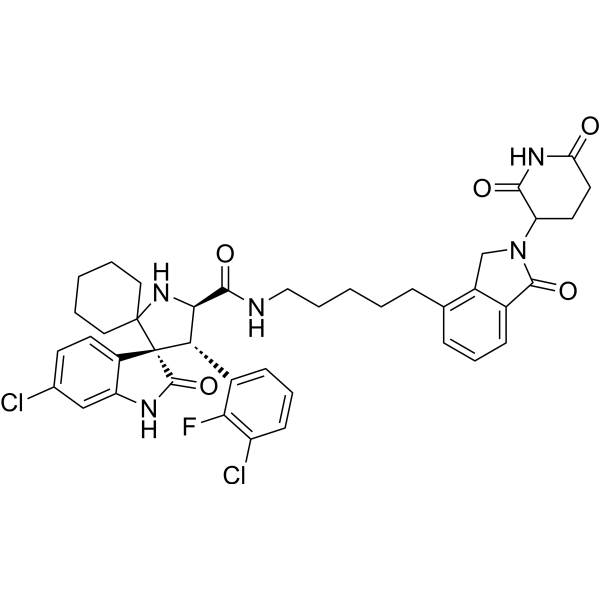Physicochemical Properties
| Molecular Formula | C41H42CL2FN5O5 |
| Molecular Weight | 774.707091808319 |
| Exact Mass | 773.254 |
| CAS # | 2411085-89-5 |
| PubChem CID | 139600332 |
| Appearance | White to off-white solid powder |
| LogP | 5.6 |
| Hydrogen Bond Donor Count | 4 |
| Hydrogen Bond Acceptor Count | 7 |
| Rotatable Bond Count | 9 |
| Heavy Atom Count | 54 |
| Complexity | 1480 |
| Defined Atom Stereocenter Count | 3 |
| SMILES | ClC1C=CC2=C(C=1)NC([C@@]12[C@@H](C2C=CC=C(C=2F)Cl)[C@H](C(NCCCCCC2=CC=CC3C(N(C4C(NC(CC4)=O)=O)CC2=3)=O)=O)NC21CCCCC2)=O |
| InChi Key | BANRYGZZIMCKNA-OYGJEQPESA-N |
| InChi Code | InChI=1S/C41H42Cl2FN5O5/c42-24-14-15-28-30(21-24)46-39(54)41(28)33(26-12-8-13-29(43)34(26)44)35(48-40(41)18-4-2-5-19-40)37(52)45-20-6-1-3-9-23-10-7-11-25-27(23)22-49(38(25)53)31-16-17-32(50)47-36(31)51/h7-8,10-15,21,31,33,35,48H,1-6,9,16-20,22H2,(H,45,52)(H,46,54)(H,47,50,51)/t31?,33-,35+,41+/m0/s1 |
| HS Tariff Code | 2934.99.9001 |
| Storage |
Powder-20°C 3 years 4°C 2 years In solvent -80°C 6 months -20°C 1 month |
| Shipping Condition | Room temperature (This product is stable at ambient temperature for a few days during ordinary shipping and time spent in Customs) |
Biological Activity
| Targets | Cereblon |
| ln Vitro | MG-277 (0.03-10 nM; 24 hours; RS4;11 cells) administration causes GSPT1 degradation and cell growth inhibition[1]. MG277 is not able to activate wild-type p53 and has much less ability to lower the amount of MDM2 protein in cells. When it comes to cancer cell lines with wild-type, mutant, or deleted p53, MG-277 is incredibly powerful and potent in inhibiting cell proliferation, suggesting a p53-independent mechanism. MG-277 causes fast GSPT1 degradation in cancer cells, but it does so in a way that is dependent on cereblon, CUL4 E3 ubiquitin ligase, and proteasomes rather than p53 or MDM2[1]. |
| Cell Assay |
Western Blot Analysis[1] Cell Types: RS4;11 cells Tested Concentrations: 0.03 nM, 0.1 nM, 0. 3 nM, 1 nM, 3 nM, 10 nM Incubation Duration: 24 hrs (hours) Experimental Results: Degraded GSPT1. |
| References |
[1]. Simple Structural Modifications Converting a Bona fide MDM2 PROTAC Degrader into a Molecular Glue Molecule: A Cautionary Tale in the Design of PROTAC Degraders. J Med Chem. 2019 Oct 21. |
Solubility Data
| Solubility (In Vitro) | DMSO : 50 mg/mL (64.54 mM) |
| Solubility (In Vivo) |
Solubility in Formulation 1: 5 mg/mL (6.45 mM) in 10% DMSO + 40% PEG300 + 5% Tween80 + 45% Saline (add these co-solvents sequentially from left to right, and one by one), suspension solution; with sonication. For example, if 1 mL of working solution is to be prepared, you can add 100 μL of 50.0 mg/mL clear DMSO stock solution to 400 μL PEG300 and mix evenly; then add 50 μL Tween-80 to the above solution and mix evenly; then add 450 μL normal saline to adjust the volume to 1 mL. Preparation of saline: Dissolve 0.9 g of sodium chloride in 100 mL ddH₂ O to obtain a clear solution. Solubility in Formulation 2: ≥ 5 mg/mL (6.45 mM) (saturation unknown) in 10% DMSO + 90% Corn Oil (add these co-solvents sequentially from left to right, and one by one), clear solution. For example, if 1 mL of working solution is to be prepared, you can add 100 μL of 50.0 mg/mL clear DMSO stock solution to 900 μL of corn oil and mix evenly. (Please use freshly prepared in vivo formulations for optimal results.) |
| Preparing Stock Solutions | 1 mg | 5 mg | 10 mg | |
| 1 mM | 1.2908 mL | 6.4540 mL | 12.9081 mL | |
| 5 mM | 0.2582 mL | 1.2908 mL | 2.5816 mL | |
| 10 mM | 0.1291 mL | 0.6454 mL | 1.2908 mL |
